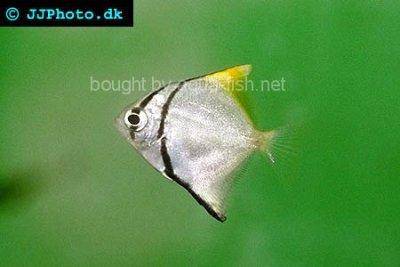Finger fish - Monodactylus argenteus
Scientific name: Monodactylus argenteus
Common name: Finger fish
Family: Monodactylidae
Usual size in fish tanks: 16 - 20 cm (6.3 - 7.87 inch)
014
Recommended pH range: 7.5 - 8.5
Recommended water hardness: 10 - 20°N (178.57 - 357.14ppm)
0°C 32°F30°C 86°F
Recommended temperature range: 24 - 28 °C (75.2 - 82.4°F)
The way how these fish reproduce: Spawning
Where the species comes from: Southeast Asia
Temperament to its own species: peaceful
Temperament toward other fish species: peaceful
Usual place in the tank: Middle levels
General Information
Monodactylus argenteus—sold as Silver Moony, Mono or Fingerfish—is a flat, diamond-shaped schooling fish from coastal estuaries and mangroves of the Indo–West Pacific (East Africa & Red Sea through South/Southeast Asia to northern Australia). Juveniles often ascend into brackish or even fresh reaches; adults are largely marine. In aquaria it commonly reaches 16–20 cm (6.3–7.9″). Keep in groups (≥5–6) for stable social behavior.
Food & Feeding
Omnivore with a strong grazing tendency. Use algae/spirulina pellets or flakes as the staple, and rotate frozen/live items (mysis, brine shrimp, chopped prawn, krill) several times weekly. Offer blanched greens (spinach, peas, nori) to support gut health. Feed modest portions 2× daily to protect water quality.
Sexing
No reliable external differences. Sexes look alike; sexing is impractical in typical home aquaria.
Breeding
M. argenteus is a pelagic egg-scatterer in nature. Home-aquarium breedings are not confirmed; commercial production (if any) involves marine conditions and large systems. Treat as display fish rather than a breeding project.
Lifespan
Typically ~8–10 years with ample space, correct salinity, and excellent water quality.
Tank Requirements & Water Parameters
- Tank size: very active, tall-bodied schooler—use a long tank of at least 150 cm / 5′ (larger preferred) for a group; provide open swimming lanes.
- Salinity (key): juveniles thrive in low brackish (≈ SG 1.005–1.010). As they mature, gradually raise to mid/high brackish (≈ SG 1.012–1.018) and ultimately near-marine (≈ SG 1.018–1.022) for adults. Avoid sudden jumps; increase over weeks.
- Water chemistry: pH 7.5–8.5; hardness 10–20 °dH (alkaline, mineral-rich water buffers pH).
- Temperature: 24–28 °C (75–82 °F) is ideal; Stability matters more than the absolute number.
- Filtration & flow: robust filtration, strong oxygenation, and some current; brackish systems need marine-grade salt mix, not „aquarium salt“.
- Aquascape: hardscape (roots/wood/rock), open water, and a tight-fitting lid—excellent jumpers.
- Maintenance: weekly water changes; avoid abrupt parameter swings.
Compatibility & Tank Mates
Generally peaceful but assertive at feeding; best in a shoal. Suitable companions are other brackish-to-marine species of similar size and activity (scats, archerfish, larger mollies in lower brackish, monos of the same species). Avoid tiny, slow or delicate freshwater fishes—long term salinity needs are incompatible.
Behaviour & Usual Place in the Tank
Active mid–upper water column swimmer; uses open water but retreats to cover when startled. Group size strongly influences confidence and reduces nipping.
Short Description
Silver Moonies are hardy, fast-moving estuary fishes that start in low brackish water and do best in increasing salinity with age, ultimately near marine as adults. Provide a large, alkaline, well-filtered tank, a mixed omnivorous diet with greens, and a proper shoal for best behavior and longevity.
Q&A
- Is freshwater okay long term? Not recommended. Keep juveniles in low brackish and raise salinity as they mature.
- How many should I keep? At least 5–6; singletons are more skittish and nippy.
- Do they eat plants? They’ll graze soft leaves; use tougher plants or macroalgae in brackish setups.
Pictures
Bought by aqua-fish.net from jjphoto.dk.







